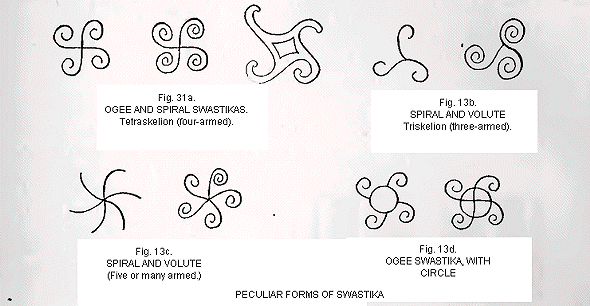

The Swastika
Definitions, Description & Origin

The Swastika has been called by different names in different countries, though nearly all countries have in later years accepted the ancient Sanskrit name of Swastika; and this name is recommended as the most definite and certain, being now the most general and, indeed, almost universal. It was formerly spelled s-v-a-s-t-i-c-a and s-u-a-s-t-i-k-a, but the later spelling, both English and French, is s-w-a-s-t-i-k-a. The definition and etymology of the word is thus given in Littre's French Dictionary:
Svastika, or Swastika, a mystic figure used by several (East) Indian sects. It was equally well known to the Brahmins as to the Buddhists. Most of the rock inscriptions in the Buddhist caverns in the west of India are preceded or followed by the holy (sacramental) sign of the Swastika. (Eug. Burnouf, "Le Lotus de la bonne loi." Paris, 1852, p.625.) It was seen on the vases and pottery of Rhodes (Cyprus) and Etruria. (F. Delaunay, Jour. off., Nov. 18, 1873, p.7024,3d col.)
Etymology: A Sanskrit word signifying happiness, pleasure, good luck. It is composed of Su (equivalent of the Greek ev), "good" and asti, "being" "good being," with the suffix ka (Greek ka, Latin co).
In the "Revue d'Ethnographie" (iv, 1885, p. 329), Mr. Dumoutier gives the following analysis of the Sanskrit, swastika:
Su, radical, signifying good, well, excellent, or suridas, prosperity.
Auti, third person, singular, indicative present of the verbs as, to be, which is sum in Latin.
Ka, suffix forming the substantive.
Professor Whitney in the Century Dictionary says, Swastika---[Sanskrit, lit. "of good fortune." Svasti (Su, well, + asti, being), welfare.] Same as fylfot. Compare Crux ansata and gammadion.
In "Ilios" (p.347), Max Müller says:
Ethnologically, Svastika is derived from srasti, and svasti from su, "well," and as, "to be." Svasti occurs frequently in the Veda, both as a noun in a sense of happiness, and as an adverb in the sense of "well" or "hail!" It corresponds to the Greek enedrea, such as are found most frequently among Buddhists and Jainas.
M. Eugèue Burnouf (1) defines the mark Swastika as follows:
A monogrammatic sign of four branches, of which the ends are curved at right angles, the name signifying, literally, the sign of benediction or good augury.
The foregoing explanations relate only to the present accepted name "Swastika." The sign Swastika must have existed long before the name was given to it. It must have been in existence long before the Buddhist religion of the Sanskrit language.
In Great Britain the common name given to the Swastika from Anglo-Saxon times by those who apparently had no knowledge whence it came, or that it came from any other than their own country was Fylfot, said to have been derived from the Anglo-Saxon fower fot, meaning four-footed, or many-footed. (2)
George Waring, in his work entitled "Ceramie Art in Remote Ages"(p.10), says:
The word [Fylfot] is Scandinavian and is compounded of Old Norse fiël, equivalent to the Anglo-Saxon fela, German viel, many, and fotr, foot, the many-footed figure.
* * * It is desirable to have some settled name by which to describe it - we will take the simplest and most descriptive, the "Fylfot."
He thus transgresses one of the oldest and soundest rules of scientific nomenclature, and ignores the fact that the name Swastika has been employed for this sign in the Sanskrit language (the etymology of the word naturally gave it the name Svastika, sv–good or well, asti–to be or being, or it is) and that two thousand and more years of use in Asia and Europe had sanctioned and sanctified that as its name. The use of Fylfot is confined to comparatively few persons in Great Britain and, possibly, Scandinavia. Outside of these countries it is scarcely known, used, or understood.
ENDNOTES:
1. "Des Sciences et Religon," p.256. [Back]
2. R.P. Greg, "The Fylfot and Swastika," Archaeologia, xlviii, part 2, 1885, p.298;H.Mis.90, pt.2-----49 [Back]
<< Previous Page Next Page >>
© 2004-2007 Northvegr.
Most of the material on this site is in the public domain. However, many people have worked very hard to bring these texts to you so if you do use the work, we would appreciate it if you could give credit to both the Northvegr site and to the individuals who worked to bring you these texts. A small number of texts are copyrighted and cannot be used without the author's permission. Any text that is copyrighted will have a clear notation of such on the main index page for that text. Inquiries can be sent to info@northvegr.org. Northvegr™ and the Northvegr symbol are trademarks and service marks of the Northvegr Foundation.

|